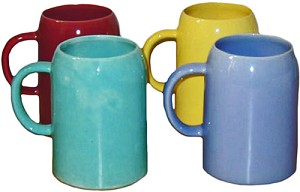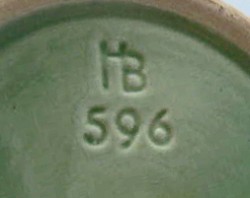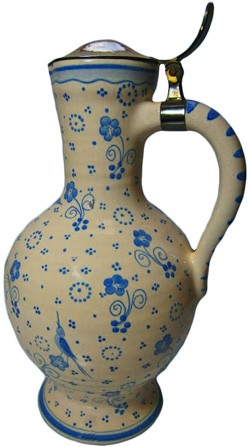Hedwig Bollhagen, Werkstätten für Keramik
Hedwig-Bollhagen-Straße 4, Oberkrämer, Marwitz, Brandenburg.
Kunst-Töpferei / Art Pottery
Hedwig Bollhagen was born in 1907. From an early age she became interested in art and ceramics. When she left school in 1924, she studied and worked for several months in a small pottery in Hesse. From 1925 she spent five semesters at the
Staatliche Keramische Fachschule, Höhr. She allowed herself to be influenced by the Bauhaus style. In 1927 she worked in the Steingutfabriken Velten-Vordamm, near Berlin, where she became the supervisor of more than 100 Malmädchen (paint-girls). She also worked for
Wilhelm Kagel until Spring 1932. In 1934 she became artistic director of a ceramics workshop in Marwitz near Berlin, where she, due to the dire economic situation, decided to produce simple, affordable crockery. The former owner of the workshop, Margarete Heymann-Loebenstein was Jewish and had been forced by the Nazis to sell the operation for much less than its true value, after it had closed on 1st July 1933. The buyer and Bollhagen's business partner,
Heinrich Schild, was a member of the Nazi Party and a leading functionary of the aligned
Gleichschaltung (forceable coordination) organization of German crafts and trades. He eventually signed the company over to her. Production began in Marwitz on May 1, 1934 with some 35 co-workers. She resisted attempts by the Nazis to co-opt her and remained true to her own design principles. She worked with the painter and ceramicist
Charles Crodel, whom the Nazis had expelled from the
Burg Giebichenstein Kunsthochschule, Halle, as a producer of degenerate art. With Crodel, who was both colleague and friend, she continually experimented with new techniques. From 1946 to 1972 she maintained her workshops as a private enterprise, despite economic difficulties. During this time she used up her life insurance policy to pay wages. But she also quickly became the best-known ceramicist in East Germany. Pottery from Marwitz soon only became available on the black market, and obtainable only by those with good connections. Hedwig Bollhagen continued working even after state control was implemented in 1972. In 1976 her facilities became part of the
Staatlicher Kunsthandelin East Germany. During reunification in 1990 they became a division of the Art Union GmbH, the successor to the Staatlicher Kunsthandel. Reprivatization took place in 1992, and at 85, Bollhagen likely became Germany's oldest entrepreneur. Hedwig Bollhagen died in Marwitz on June 8, 2001. She is buried in Hanover, the city of her birth.
The company continues in production.
Reference:
Hedwig Bollhagen Fembio Wikipedia


